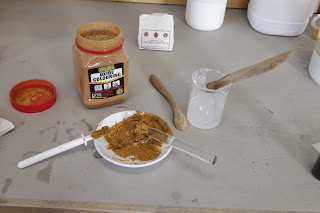 |
| MS 201.4 © The Fitzwilliam Museum |
What goes wrong with the pigment?
 |
| Example of cracking, flaking and loss in MS 201.4 © The Fitzwilliam Museum |
Powdering can be caused if the artist used too little binder, or if the binder was too weak. Very coarsely ground pigments may be too heavy for the binder and so subject to powdering; the pigment may be attached until the parchment is dessicated and shrinks in low relative humidity, causing an already weak binder to fail.
Pigments themselves can also be the cause of the damage. Copper-based pigments can corrode, weakening or destroying the substrate they are painted on. Silver gilding tends to oxidize and darken over time. When some pigments are painted immediately next to one another they may react and cause damage. For example, the sulfide in orpiment will react with lead-based pigments such as lead white to form lead sulfide, visible as a blackening in white areas. Chemical deterioration is facilitated by moisture, and when cut from the protective environment of a manuscript, damage to a fragment may be accelerated as it is more vulnerable to changes in relative humidity.
Cracking and flaking of media can be seen in most of the fragments being conserved in this project. Many fragments are in need of pigment consolidation to stabilise them because of this. While these problems are visible to the naked eye, until microscopic examination and documentation is conducted it is not possible to know the severity of the damage. Some areas of cracking and flaking may not be active damage and therefore will not require consolidation. For example, if a pigment appears to be powdering but does not seem loose when checked under magnification it may indicate that some of the pigment did not mix with the binder properly. While some pigment was lost, the rest of the pigment would be firmly attached and not at risk to future damage.
Practice
I am in the process of conducting microscopic examination
and documentation of pigment damage before beginning consolidation of pigments.
With my limited experience handling pigments and understanding of pigment
damage, I am also practising pigment consolidation before treating pigments on any of the fragments.
For this exercise I created several samples imitating the
flaking, cracking and powdering seen in the historic manuscript fragments. These act as test pieces on which I can practice to gain experience using consolidation techniques and adhesives. I did not attempt to imitate the same circumstances that
lead to the damage of the pigments, but instead concentrated on imitating the
current condition of the pigments.
Cracking and flaking:
To imitate cracking and flaking, I used a heavily applied iron oxide using Laponite as a binder. Laponite is a synthetic layered silicate sometimes used as a cleaning poultice in object conservation. Like many silicate compounds it will shrink and crack if allowed to dry in an uncontrolled way.
I prepared the Laponite with water and after it dissolved and solidified as a gel I added the iron oxide. After a few small tests, I found that a thick application cracked and flaked as it dried.
Powdering:
To imitate powdering I used carbon black mixed with water and did not add any binder.
The pigment appeared to be well-adhered to the parchment until it was tested with a small brush, whereupon it detached. For this reason, on historic objects it is important to rely not only on what can be observed, but physical examination too.
Preparation:
I painted these pigments on the hair side of one parchment offcut and onto the flesh side of another offcut. On the flesh side I painted two squares of each pigment.
On the flesh side I wanted to better simulate the combinations and overlaps of different pigments as they would appear in the actual media. I drew a copy of a hare riding a hound from the Macclesfield Psalter and painted it carefully so that consolidating the two pigments would be more similar to those in the fragments.
Cracking and flaking:
To imitate cracking and flaking, I used a heavily applied iron oxide using Laponite as a binder. Laponite is a synthetic layered silicate sometimes used as a cleaning poultice in object conservation. Like many silicate compounds it will shrink and crack if allowed to dry in an uncontrolled way.
 |
| Iron oxide mixed with Laponite gel |
 |
| Parchment tensioned as the pigment dried. |
Powdering:
To imitate powdering I used carbon black mixed with water and did not add any binder.
 |
| Carbon black mixed with water |
The pigment appeared to be well-adhered to the parchment until it was tested with a small brush, whereupon it detached. For this reason, on historic objects it is important to rely not only on what can be observed, but physical examination too.
 |
| Carbon black detached easily onto my finger. |
Preparation:
I painted these pigments on the hair side of one parchment offcut and onto the flesh side of another offcut. On the flesh side I painted two squares of each pigment.
On the flesh side I wanted to better simulate the combinations and overlaps of different pigments as they would appear in the actual media. I drew a copy of a hare riding a hound from the Macclesfield Psalter and painted it carefully so that consolidating the two pigments would be more similar to those in the fragments.
 |
| Pigment on flesh side of parchment, using imagery from Macclesfield Psalter. |
 |
| Original detail of Macclesfield Psalter MS 1-2005 © The Fitzwilliam Museum |
The next post will be about removing fragments from old mounts, and 'Pigment Consolidation part 2' will be posted in January. To be kept updated about new posts, please email me here with the subject 'blog subscription' and I will add you to my mailing list.

No comments:
Post a Comment